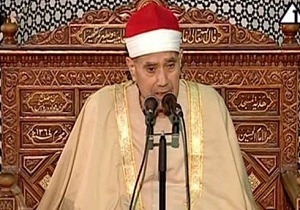A Technical, Aesthetic Analysis of Raghib Mustafa Ghalwash’s Quran Recitations

This is according to Ali Reza Sepahvand, an Iranian composer, who, in an article, elaborated on the aesthetic and technical aspects of the late Egyptian Quran master’s recitations.
The article is as follows:
The recitation of the Holy Quran has an unparalleled place among the vocal arts of the Islamic world. In this field, Egyptian reciters have always been pioneers of vocal and artistic techniques. Among the brilliant names of contemporary recitation, Raghib Mustafa Ghalwash was one of the prominent figures whose recitation style is considered a blend of technical skill, musical taste, and Quranic spirituality.
The late qari was among Quran reciters who, while benefiting from the tradition of great masters, was able to create his own unique vocal signature and this is a signature that found a large audience not only in Egypt but also in other Islamic countries, especially Iran.
In this article, an attempt is made to examine Ghalwash’s recitation style from the perspective of Arabic-Quranic music, the choice of Maqams (melody types), vocal techniques, and performance techniques in order to present a clear picture of his vocal and intellectual system in recitation.
The life and artistic position of Ghalwash
Ghalwash was born in 1938 in one of the religious cities of Egypt and began memorizing and reciting the Quran from a young age. His talent was noticed by voice and tone masters in his early years. After undergoing the stages of Tajweed and interpretation, he entered Quranic circles and recited on the Egyptian Quran Radio as one of the official reciters.

Artistically, Ghalwash was a follower of the vocal school of great reciters such as Mustafa Ismail and Abdul Basit Muhammad Abdul Samad, but instead of mere imitation, he tried to create a personal expression by combining the characteristics of these two schools. In fact, he did not consider recitation to be just reading out verses, but rather an artistic expression of meaning, for this reason, the element of emotion and conceptual understanding played a prominent role in each recitation.
Read More:
Ghalwash traveled to our country (Iran) many times and recited in Quranic circles and as an honorary qari of the international Quran competitions of the Islamic Republic of Iran. His deep connection with Persian-speaking listeners began from here, and his recitations are still known in Quranic circles as an example of “beauty with dignity”.
Musical Maqams and Dastgahs (standard musical systems) in Master Ghalwash’s recitation
In Arabic-Quranic music, Maqam refers to the melodic and emotional framework that the reciter uses to express meaning. Choosing the right Maqam and how to change them (modulation or modulating) are among the most important elements of aesthetics in recitation. Master Ghalwash, with a thorough understanding of this vocal system, skillfully uses a set of Maqams in his recitation.
1. Maqam of Bayat
In most of the master’s recitations, the work begins with the Maqam of Bayat. This Maqam has a calm, humble, and appropriate atmosphere of humility. Ghalwash uses a warm, soft, and medium voice in performing the Maqam of Bayat and gradually raises the tones, drawing the listener into the atmosphere of the recitation. In his voice, the Bayat is not only the initial Maqam, but also a platform for semantic expression, especially in verses of mercy and glad tidings.
2. Maqam of Rast
One of Ghalwash’s favorite Maqams is Rast. This Maqam has dignity, stability, and grandeur in its structure and is often used for strong verses or expressions of divine power. After starting in Bayat, Ghalwash usually enters Rast in a smooth and gradual manner. In this transition, the change of pitches is so natural that the listener does not notice the boundary between the two Maqams, and professional reciters know how difficult this change of tone is in the Ghalwash style. This style is a sign of his mastery of the logic of intervals and sound combinations.
3. Maqam of Saba
In parts of the recitation where the content of the verse refers to sadness, supplication, or sorrow, the master uses the Maqam of Saba. Saba has a sad and emotional tone due to its special intervals. Ghalwash usually uses Saba at the end of invocational passages or when mentioning divine punishment, and then returns the recitation to its original state by turning to Bayat or Rast.
4. Maqma of Shur
The Maqam of Shur is a branch of Bayat that can be described as a combination of Hijaz in ascending movements and Bayat in descending movements. This Maqam has a mystical and contemplative tone. In some of Ghalwash’s recitations, especially in the Meccan Surahs, one can hear his brief entry into Shur. This Maqam is very suitable for reflective verses and direct addresses to humans, and Ghalwash uses it delicately to make the audience pause and think.
5. Composition and transition between Maqams
Ghalwash’s outstanding feature in using Maqams is “soft modulation or modality”. He avoids sudden jumps and leaps and, by carefully adjusting the intervals, moves the listener from one Maqam to another without shock. Such a skill requires theoretical knowledge of Arabic music and high aural comprehension. This feature is also seen in Mustafa Ismail’s style, but Ghalwash performs it with a softer and more controlled voice.
Technical and artistic techniques in Ghalwash’s recitation
Master Ghalwash is not satisfied with just choosing the right Maqam, but at the technical level, he uses a set of methods and subtleties in the service of meaning. The following is an examination of his most important vocal and technical features.
1. Precision in the pronunciation and characteristics of letters
One of the most striking technical aspects of Ghalwash’s recitation is his exemplary precision in pronouncing letters. Each letter is pronounced with its own specific pronunciation and with full observance of characteristics. The listener clearly feels that the reciter does not neglect any word. This precision allows the beauty of the voice to serve the meaning and the recitation to acquire a spiritual and balanced state.
2. Tahrir and vocal ornaments
Tahrir (a vocal technique) in recitation is the controlled decoration and vibration or vibrato of the voice that gives life to the melody. Master Ghalwash uses Tahrir not to show off his skill, but to emphasize the concept, but he links this issue to the aesthetic category of recitation in such a way that the listener receives both messages beautifully. His Tahrirs are usually short, precise, and proportionate to the weight of the verse. In Bayat and Rast, Tahrir is performed at a moderate pace, while in the Maqam of Saba or Shur, the vibrations are slower and more emotional.
3. Vocal range and flexibility in pitches
Ghalwash’s voice has a relatively wide range, from soft, resonant lows to clear, powerful highs. He rarely uses a strong voice, preferring to move within a controlled range. This control allows him to make precise transitions between maqams without vocal strain. His breathing power is also remarkable, as he performs long Quranic sentences in one breath, without reducing the quality of his voice.
4. Time management, pauses, and silence
In the recitation of Ghalwash, silences play an important role. He knows well that a short silence between two verses can be more effective than a continuous, uninterrupted vocal continuation. This skill in arranging the “Waqf and Ibtida” is a sign of his deep semantic understanding of the Quranic text. He pauses not only at syntactic positions, but also at points of spiritual impact, so that the message of the verse penetrates the listener’s mind.
5. Harmony of meaning and sound
One of the most prominent features of Ghalwash’s recitation is the precise connection between content and melody. In the verses of mercy, his tone becomes soft and pleasant; in the verses of warning, his voice becomes firm and decisive; and in the monotheistic sections, he recites the Maqam of Rast with particular firmness. He does not use a merely beautiful tone for emotional impact, but rather arranges each melody in accordance with the content of the verse. It is this harmony that elevates his recitation from mere music to the level of “divine expression”.
6. Use of sound dynamics
Ghalwash uses changes in the intensity of his voice (dynamics) to emphasize meaning. For example, when mentioning the attributes of God, he lowers his voice to convey a sense of humility, and in verses related to divine power, he gradually raises his voice to convey the grandeur of the subject. This precise control of dynamics is one of the signs of his artistic maturity.

Analysis of the structure of the recitation
To better understand Ghalwash’s recitation system, the overall structure of his recitations can be divided into several stages:
1. A calm introduction with verses
The recitation begins with a calm introduction in verses. The initial verses are usually performed in a low vocal range so that the listener’s ear becomes familiar with the tone. In this section, the words are pronounced with complete clarity and the notes are few.
2. A gradual ascent to the state of Rast
Furthermore, as the semantic tension increases or the key verses are entered, the reciter gradually enters the state of Rast. At this point, vocal peaks emerge and the power of the larynx becomes apparent. This section is usually the center of gravity of the recitation.
3. Creating variety with secondary positions
After the peak, to maintain auditory diversity, Ghalwash uses secondary positions such as Shur or Saba. These sections create a more emotional atmosphere and distract the listener from monotony.
4. A calm return to the verses and the end of the recitation
At the end, he returns to the verses again to end the recitation with the same calm as the beginning. Interestingly, the way the verses are read in the return, although it follows the same initial verse, is different from this and in this way, creates variety in the recitation and the descending section. This return is like a complete musical circle that keeps the beginning and the end in harmony.
Listen:
As a result, the recitation of Raghib Mustafa Ghalwash is a model of the connection of art and spirituality. With his deep knowledge of Arabic Maqams and complete mastery of Tajweed techniques, he has created a recitation that is both pleasing to the ear and meaningful. His voice is warm and gentle, and while beautiful, it is free from exaggeration and artificiality.
Among the Maqams, Bayat and Rast are the most prominent in his works, and the intelligent use of Saba and Shur adds a touch of emotion and thought to his recitation. Ghalwash is a suitable model for young reciters not only from an artistic perspective, but also from an educational perspective, because it shows that the beauty of sound is valuable when it serves understanding and humility.
Read More:
His recitation can be considered a kind of “romantic expression of meaning,” an expression in which voice and verse intertwine to resonate the truth of the Quran in the ears and hearts of the listener.
4311261



